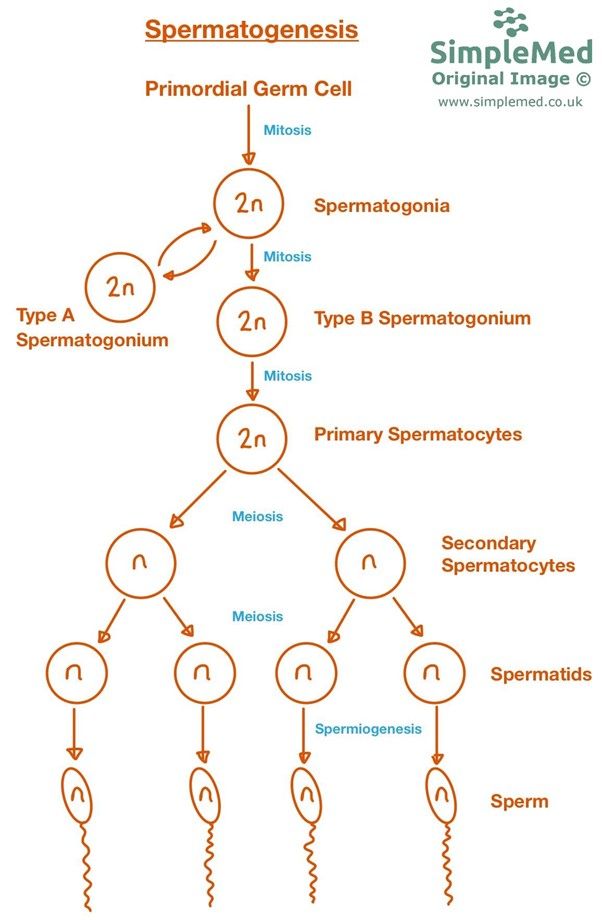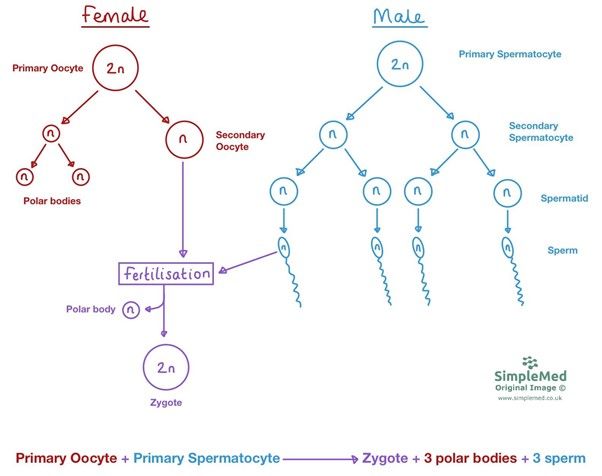Next Lesson - Sex, Infertility and Contraception
Abstract
- Gametogenesis is the production of sex cells (gametes) through meiosis.
- Spermatogenesis involves the following transitions: primordial germ cells -> spermatogonia -> type B spermatogonia -> primary spermatocyte -> secondary spermatocyte -> spermatids. Spermatogonia also produce type A spermatogonia which are recycled to replenish the spermatogonia supply.
- Spermiogenesis is the transition of spermatids into mature sperm cells, with spermiation ending with mobile sperm.
- Sperm capacitation is the final step to allow for fertilisation. It involves the removal of glycoproteins and cholesterol and activating signalling pathways.
- The Spermatogenic cycle is the time taken for the same stage of spermatogenesis to appear in the same segment of the seminiferous tubule.
- The Spermatogenic wave is the appearance of the different stages of spermatogenesis in the seminiferous tubules in a sequential and ‘wave like’ motion.
- Formation of oocytes begins before birth, arresting in prophase I, becoming primary oocytes surrounded by follicular cells, called primordial follicles. Most of these undergo atresia before puberty. 15-20 primordial follicles mature each month, developing cuboidal epithelium with granulosa and theca cells in the preantral stage. In the antral stage, spaces between granulosa cells coalesce to form the antrum. Only one oocyte reaches the preovulatory phase, finishing meiosis I and forming a secondary oocyte.
- Ovulation occurs, releasing the oocyte into the fimbriae of the fallopian tubes, passing down it by peristalsis towards the uterus. Because ovulation is a traumatic action, increased ovulation may be related to increased ovarian cancer incidence.
- The corpus luteum is formed from the theca interna and granulosa cells, secreting progesterone and oestrogen causing the uterus to enter the proliferative phase. If β-hCG is released by the implanted zygote, the corpus luteum persists and releases progesterone for 4 months until the placenta takes over. If no β-hCG is released, the corpus luteum forms a mass of scar tissue called the corpus albicans, stopping progesterone release and causing menstruation.
Core
Gametogenesis – the process of making sex cells (gametes) through meiosis. This occurs in the testes in males, and in the ovaries (and the fallopian tubes) in females.
Spermatogenesis is the process that creates sperm from primordial germ cells in the testicles. It has a number of steps, which are listed below and included in the diagram:
- The primordial germ cell divides by mitosis to produce spermatogonia.
- The spermatogonia divides by mitosis to produce two types of cells:
- Type A Spermatogonium – replace the spermatogonia in a loop, will divide into type A and type B spermatogonia in the future.
- Type B Spermatogonium – continue along the spermatogenesis pathway to produce sperm.
- Type B spermatogonium divide by mitosis to form primary spermatocytes.
- Primary spermatocytes divide by meiosis to form secondary spermatocytes.
- Secondary spermatocytes go through meiosis to turn into spermatids.
- Spermatids continue through spermiogenesis to produce sperm cells.
Spermiogenesis is the final stage in the production of sperm cells and involves the transition of spermatids into motile sperm cells.
Spermiation is the outcome of spermiogenesis. Spermiation occurs when the spermatids are released into the lumen of the seminiferous tubules. They then pass through the rete testis and ductuli efferentes and into the epididymis. Spermatids are not mobile until they pass through the epididymis. Before this, they are transported by Sertoli cells secretion and peristalsis, and once they undergo spermiation, they are mobile and are mature sperm cells.

Diagram - Spermatogenesis and spermiogenesis
SimpleMed original by Maddie Swannack
Capacitation of sperm is the final step before sperm becomes able to fertilise an oocyte. Capacitation occurs in the female reproductive tract following ejaculation. It involves the removal of glycoproteins and cholesterol from the sperm membrane and activation of signalling pathways inside the sperm cells. Removal of the glycoproteins allows the sperm to bind to the zona pellucida of the oocyte and initiate the acrosome reaction. This is the process that allows the sperm to penetrate the egg cell and begin fertilisation.
Capacitation is an important consideration in in vitro fertilisation (IVF). As the sperm never encounters the female reproductive tract before meeting the egg, the sperm must be treated in a capacitation medium to trigger the process artificially.
Not all the stages of spermatogenesis are visible histologically in a single cross-section of a seminiferous tubule. This observation confirms that sperm is produced continuously rather than batch produced.
The spermatogenic cycle is the time taken for the same stage of spermatogenesis to appear in the same segment of the seminiferous tubule. Simply put, how long it takes to produce one fully mature sperm cell from a spermatogonium. In humans this takes around 16 days.
The spermatogenic wave is the appearance of the different stages of spermatogenesis in the seminiferous tubules in a sequential and ‘wave like’ motion. This wave-like movement is the spermatogenic wave.
The oocyte (pronounced o-o-cyte not oo-cyte) is the female gamete and is also known as an egg cell. A woman is born with all her oocytes formed but not fully developed in her ovaries. This stock declines after birth with age due to atresia (cell death).
Formation of oocytes begins before birth. Germ cells differentiate into oogonia and proliferate by mitosis. The oogonia then begin meiosis, but arrest in prophase I (meaning they have replicated their chromosomes but not commenced division). At this point, the oogonia become primary oocytes. These primary oocytes number approximately 2 million, and each one is surrounded by a flat layer of epithelial cells called follicular cells. The primary oocytes surrounded by follicular cells are named primordial follicles.
Most of these primordial follicles undergo atresia during childhood, leaving approximately 40,000 in the ovaries by the start of puberty. From puberty onwards, 15-20 oocytes mature each month, passing through the following three stages:
As primordial follicles grow, the epithelium changes from flat to cuboidal. A number of new cell types develop: granulosa cells secrete a glycoprotein layer named zona pellucida, and the theca interna cells become paracrine tissue, going on to produce testosterone under the influence of LH so granulosa cells can turn it into oestrogen.
As development continues, fluid filled spaces appear between granulosa cells, which coalesce to form the antrum (the name for the largest fluid filled sac). Several follicles (15-20) begin development every menstrual cycle but only one progresses to the preovulatory stage.
An increase in FSH and LH induce growth. The primary oocyte then enters meiosis I. However, in division the cytoplasm is not evenly distributed. The majority is given to the secondary oocyte and the minority to the first polar body. The polar bodies never become an egg and in effect are dustbins for unneeded genetic material. The secondary oocyte then enters meiosis II and halts until it is fertilised.
Before ovulation occurs, the fimbriae of the fallopian tube sweep the surface of the ovary, and the peristaltic action of the fallopian tube begins. This means that as soon as ovulation occurs, the fallopian tubes are doing everything they can to make sure the oocyte progresses into the uterus.
Ovulation occurs when the graafian/ovarian follicle (the follicle containing the secondary oocyte) becomes approximately 2.5cm in size. The LH surge increases collagenase activity (an enzyme that breaks down collagen), and prostaglandin release causes ovarian wall contractions. This causes the oocyte to be extruded from the ovary in a traumatic release.
The fallopian tube then acts to move the oocyte into the uterus through peristaltic contractions and fimbriae movements. The fallopian tubes are also lined with cilia which help to waft the oocyte towards the uterus.
As the oocyte leaves the ovary through a traumatic rupture, repeated repair is needed. This means that there is an increase in cellular proliferation is needed at these sites, which can increase the risks of some types of ovarian cancer. This means that increased ovulation can lead to an increased risk of ovarian cancer.
Preventing ovulation can therefore be a protective factor for ovarian cancer, meaning that multiparous women (women who have had more than one child, ovulation pauses during pregnancy) and women who use birth control methods that prevent ovulation (such as the combined oral contraceptive pill) are at a lower risk of ovarian cancer.
Mittelschmerz or ovulation pain which occurs on ovulation. It is unknown what specifically causes the pain. One theory is that fluid or blood from the follicle irritate the abdomen. Alternatively it is though that if the epithelium of the ovary is too well innervated when the oocyte traumatically ruptures from the ovary it can cause pain. The term gets its name from the fact that the painful ‘schmertz’ ovulation occurs on the 14th day of the cycle, in the middle ‘mittel’ of the month. It is important, however, that abdominal pain in a woman is not dismissed to be Mittelschmerz pain.

Diagram - Processes from meiosis to fertilisation
SimpleMed original by Maddie Swannack
The corpus luteum (lit. ‘yellow body’) is formed from the remains of the ovarian follicle (graafian) including the remaining granulosa and theca interna cells. As the cells become vascularised they change into yellow coloured lutein cells. The corpus lutetium secretes oestrogen and progesterone, which stimulates the uterine mucosa to enter the proliferative stage to prepare for implantation of the fertilised oocyte.
If fertilisation occurs, β-hCG release prompts the corpus luteum to grow and form the corpus luteum graviditatis, which continues to secrete progesterone until the 4th month of pregnancy, when the placenta takes over progesterone production. The progesterone released maintains the thick lining of the endometrium.
If the corpus luteum does not receive β-hCG signals from the implanted zygote (oocyte and sperm combo) within 14 days, it dies and turns into the corpus albicans.
The corpus albicans (lit. ‘white body’) is essentially scar tissue formed from the regressed corpus luteum and does not release progesterone. As a result the endometrial lining breaks down which is observed as menstruation.

Table - Differences between spermatogenesis and oogenesis
SimpleMed original by Maddie Swannack
Edited by: Dr. Ben Appleby
Reviewed by: Dr. Thomas Burnell
- 7010

